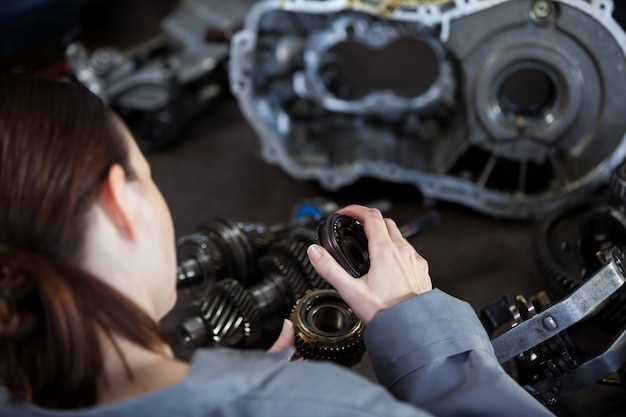Troubleshooting a Noisy Drivetrain

Experiencing unusual noises from the drivetrain of your vehicle can be alarming, indicating potential underlying issues that need to be addressed promptly. The drivetrain is a crucial component, responsible for transferring power from the engine to the wheels, and any anomalies can affect overall performance and safety. Understanding how to identify and troubleshoot these noises is essential for vehicle maintenance and longevity.
There are various types of noises that may originate from the drivetrain, each signaling different problems. For example, grinding, clunking, or whining sounds may suggest issues with gears, bearings, or other critical components. Recognizing the nature of the noise, along with the specific driving conditions when it occurs, can help in diagnosing the issue more effectively. By paying close attention to these details, vehicle owners can save time and money on repairs.
This article will guide you through the process of diagnosing and troubleshooting noisy drivetrain issues. From basic inspections to more in-depth analyses, we aim to equip you with the knowledge and confidence to address these concerns proactively. Whether you are a seasoned mechanic or a novice car owner, the information provided will be valuable in ensuring your vehicle operates smoothly and efficiently.
Identifying Common Drivetrain Noises and Their Sources
Drivetrain noises can signal various issues within your vehicle, often indicating that something requires attention. Understanding the types of noises your drivetrain might produce can help pinpoint potential problems early. Below, we outline common drivetrain noises and their likely sources.
One of the most recognizable sounds is a clunking noise when shifting gears. This often originates from worn or damaged universal joints or transmission mounts. Inspecting these components can reveal whether they need lubrication or replacement to resolve the issue.
Another frequent noise is a grinding sound when engaging gears. This typically indicates issues with the transmission, often due to low fluid levels or worn synchronizers. Checking the transmission fluid and ensuring it is at the appropriate level is vital for smooth operation.
A high-pitched whine while accelerating may stem from problems with the differential or the gearbox. This sound can occur when the gears are worn or if there is inadequate lubrication. Regular maintenance, including checking gear oil levels, can help prevent such noises.
If you hear a ratcheting or clicking sound while turning, it’s likely associated with the CV (constant velocity) joints in front-wheel drive vehicles. These joints can wear out over time, particularly in older models or those that frequently operate on rough terrain. Timely replacement of damaged CV joints is essential to avoid further drivetrain damage.
A rumbling or humming noise that increases with speed may indicate tire issues or failing bearings. It’s crucial to inspect tires for uneven wear and check wheel bearings for play or damage. Addressing these concerns early can prevent more extensive repairs down the line.
Finally, a whining noise during deceleration might suggest issues with the torque converter or the automatic transmission. Similar to previous issues, conducting regular fluid checks and system inspections can mitigate costly repairs that could arise from unnoticed problems.
Recognizing these sounds early can help maintain the integrity of your drivetrain and ensure a smoother, more efficient driving experience. When in doubt, consulting a professional mechanic can provide you with the necessary insight and repair options.
Steps to Diagnose and Isolate Drivetrain Noise Problems

Diagnosing drivetrain noises can be a complex task, but following a systematic approach can help isolate the issue. Begin by gathering information about the noise: when it occurs, under what conditions, and its characteristics.
Step 1: Identify the Type of Noise
Listen carefully to the noises produced by the drivetrain. Common types include grinding, clunking, whining, and clicking. Each type may indicate a different issue, such as worn bearings, improper lubrication, or misaligned components.
Step 2: Reproduce the Noise
Attempt to replicate the noise under various conditions. Drive at different speeds, accelerate, decelerate, and navigate turns. Pay attention to whether the noise is present when the vehicle is in gear, coasting, or stationary.
Step 3: Inspect for Obvious Signs
Conduct a visual inspection of the drivetrain components, including the transmission, differential, driveshafts, and axles. Look for leaks, cracks, or loose parts that may contribute to the noises.
Step 4: Check Fluid Levels and Condition
Verify that all relevant fluids are at the correct levels and are in good condition. Low or dirty fluids can lead to noise issues. Replace any contaminated fluids as necessary.
Step 5: Conduct a Road Test
Take the vehicle for a thorough road test while listening for noises. Note if the sounds change when turning or applying brakes, which can indicate issues with the wheel bearings or CV joints.
Step 6: Isolate the Source of Noise
Using a mechanic’s stethoscope, check various drivetrain components to pinpoint the source of the noise. Place the stethoscope on parts like the transmission and differential to listen for abnormal sounds.
Step 7: Consult Technical Resources
Refer to vehicle service manuals and technical bulletins specific to your car model. These resources often contain guidelines on diagnosing common drivetrain noises and issues.
Step 8: Seek Professional Help
If the source of the noise remains elusive, consider enlisting the help of a professional mechanic. Their experience and specialized tools can assist in accurately diagnosing and resolving the problem.
By meticulously following these steps, you can effectively diagnose and isolate drivetrain noise problems, ensuring your vehicle operates smoothly and safely.
Repair Solutions for Specific Drivetrain Noise Issues

Identifying and addressing drivetrain noise issues is crucial for maintaining a vehicle’s performance and longevity. Different types of noise can stem from various components within the drivetrain, such as the transmission, differential, or driveshaft, and each requires targeted solutions.
If you experience a whining noise when accelerating, this could indicate a problem with the transmission fluid level or quality. Start by checking the transmission fluid. If it’s low or dirty, replace it and monitor noise levels afterward. If the noise persists, further inspection may reveal worn bearings or gear issues inside the transmission, requiring professional assessment.
A clunking noise when shifting or during acceleration can often be traced to worn or damaged universal joints in the driveshaft. To resolve this, inspect the universal joints for play or damage. If they appear worn, replacement is necessary to restore smooth operation and eliminate the noise.
Grinding noises when shifting gears typically suggest a problem with the clutch or synchronizers, particularly in manual transmissions. Begin by checking the clutch adjustment and ensuring it disengages fully. If the clutch operates correctly and grinding continues, the synchronizers may be worn and may need replacement to facilitate proper gear engagement.
If there’s a clicking or popping noise when turning, this often points to a failing CV joint in front-wheel-drive vehicles. Inspection of the CV boots will reveal any tears or leaks; if damage is found, the entire CV joint must be replaced to correct the noise and prevent further drivetrain damage.
In cases where a growling noise is observed while the vehicle is in motion, it may indicate a failing wheel bearing or differential issue. To address this, check for play in the wheel bearings and listen for noises while turning. A worn bearing will likely require replacement. For differential concerns, ensure proper fluid levels and inspect for any metal shavings or debris, indicating internal damage requiring service.
By systematically addressing specific types of drivetrain noises, a vehicle owner can effectively troubleshoot and repair issues, ultimately ensuring smooth and reliable operation of their vehicle.

